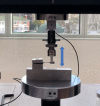Fatigue behavior of removable partial denture cast and laser-sintered cobalt-chromium (CoCr) and polyetheretherketone (PEEK) clasp materials
- PMID: 35938907
- PMCID: PMC9760146
- DOI: 10.1002/cre2.645
Fatigue behavior of removable partial denture cast and laser-sintered cobalt-chromium (CoCr) and polyetheretherketone (PEEK) clasp materials
Abstract
Objective: To investigate the fatigue behavior of cast and laser-sintered cobalt-chromium (CoCr) and polyetheretherketone (PEEK) material for a removable partial denture (RPD) clasps.
Methods: Dumbbell-shaped specimens were digitally designed with the center part of the dumbbell being a half-round shape at the cross-sectional dimension of 1.25 mm to simulate a typical clasp design and dimensions. A fatigue machine with an offset axis rotation system simulated a typical undercut depth of 0.25, 0.50, and 0.75 mm. Each group was subjected to 30,000 fatigue cycles (simulating 21 years) or till specimen failure. Before testing, the stress value at each undercut depth for each specimen was established in a universal testing machine and SN curves were plotted for each group. Data were statistically analyzed using Kruskal-Wallis and post hoc tests. The fractured surfaces were analyzed using SEM.
Results: The average fatigue cycles with 0.25, 0.50, and 0.75 mm undercuts were 27,155 ± 6277, 9298 ± 4033, 5642 ± 8785 for cast CoCr and 26,765 ± 6150, 11,318 ± 7931, 2861 ± 4803, for laser-sintered CoCr, respectively. Apart from three specimens, the PEEK groups did not fail during the simulation period. Clasps with 0.25 mm deflection showed significantly higher fatigue resistance than other groups (p < .001). There was no significant difference in fatigue behavior between the cast and laser-sintered CoCr. Microporosities at the fractured site along with irregular crack propagation were observed for cast and laser-sintered CoCr specimens. Fatigue-induced broken polymer crosslinking chains were observed in PEEK specimens.
Conclusion: PEEK material exhibited the highest fatigue resistance and significantly lower deflection resistance. Cast and laser-sintered CoCr showed similar fatigue resistance and behavior.
Keywords: CAD/CAM; Cast CoCr; PEEK; denture clasps; fatigue; laser-sintered CoCr; removable partial denture.
© 2022 The Authors. Clinical and Experimental Dental Research published by John Wiley & Sons Ltd.
Conflict of interest statement
The authors declare no conflict of interest.
Figures






Similar articles
-
Retention and fatigue performance of modified polyetheretherketone clasps for removable prosthesis.J Mech Behav Biomed Mater. 2024 Jun;154:106539. doi: 10.1016/j.jmbbm.2024.106539. Epub 2024 Apr 8. J Mech Behav Biomed Mater. 2024. PMID: 38598917
-
Different Undercut Depths Influence on Fatigue Behavior and Retentive Force of Removable Partial Denture Clasp Materials: A Systematic Review.J Prosthodont. 2023 Feb;32(2):108-115. doi: 10.1111/jopr.13519. Epub 2022 Apr 28. J Prosthodont. 2023. PMID: 35405767
-
Retentive Forces of Removable Partial Denture Clasp Assemblies Made from Polyaryletherketone and Cobalt-Chromium: A Comparative Study.J Prosthodont. 2022 Apr;31(4):299-304. doi: 10.1111/jopr.13398. Epub 2021 Jun 22. J Prosthodont. 2022. PMID: 34081360
-
An analytical model to design circumferential clasps for laser-sintered removable partial dentures.Dent Mater. 2018 Oct;34(10):1474-1482. doi: 10.1016/j.dental.2018.06.011. Epub 2018 Jun 21. Dent Mater. 2018. PMID: 29937332
-
Polyetheretherketone materials for removable partial denture frameworks: an integrative review.Gen Dent. 2023 Jul-Aug;71(4):58-62. Gen Dent. 2023. PMID: 37358585 Review.
Cited by
-
Clinical Applications of Polyetheretherketone in Removable Dental Prostheses: Accuracy, Characteristics, and Performance.Polymers (Basel). 2022 Oct 31;14(21):4615. doi: 10.3390/polym14214615. Polymers (Basel). 2022. PMID: 36365609 Free PMC article. Review.
-
Evaluate the clinical performance of Bio-HPP and Vitallium frameworks in free-end removable partial dentures.Sci Rep. 2025 Aug 6;15(1):28777. doi: 10.1038/s41598-025-11370-7. Sci Rep. 2025. PMID: 40770272 Free PMC article. Clinical Trial.
-
PEEK for Oral Applications: Recent Advances in Mechanical and Adhesive Properties.Polymers (Basel). 2023 Jan 11;15(2):386. doi: 10.3390/polym15020386. Polymers (Basel). 2023. PMID: 36679266 Free PMC article. Review.
References
-
- Aarts, J. M. , Choi, J. J. E. , Metcalfe, S. , & Bennani, V. (2021). Influence of build angulation on the mechanical properties of a direct‐metal laser‐sintered cobalt‐chromium used for removable partial denture frameworks. The Journal of Prosthetic Dentistry, 126(2), 224–230. - PubMed
-
- Akl, M. A. , & Stendahl, C. G. (2022). Removable partial denture frameworks in the age of digital dentistry: A review of the literature. Prosthesis, 4(2), 184–201.
-
- Cheng, H. , Xu, M. , Zhang, H. , Wu, W. , Zheng, M. , & Li, X. (2010). Cyclic fatigue properties of cobalt‐chromium alloy clasps for partial removable dental prostheses. The Journal of Prosthetic Dentistry, 104(6), 389–396. - PubMed
-
- Darvell, B. W. (2018). Materials science for dentistry. Woodhead Publishing.
-
- El‐Baz, R. , Fayad, M. , Abas, M. , Shoieb, A. , Gad, M. , & Helal, M. A. (2020). Comparative study of some mechanical properties of cobalt chromium and polyether ether ketone thermoplastic removable partial denture clasps: An in‐vitro study. Brazilian Dental Science, 23(3), 1–6.
MeSH terms
Substances
LinkOut - more resources
Full Text Sources
Miscellaneous

